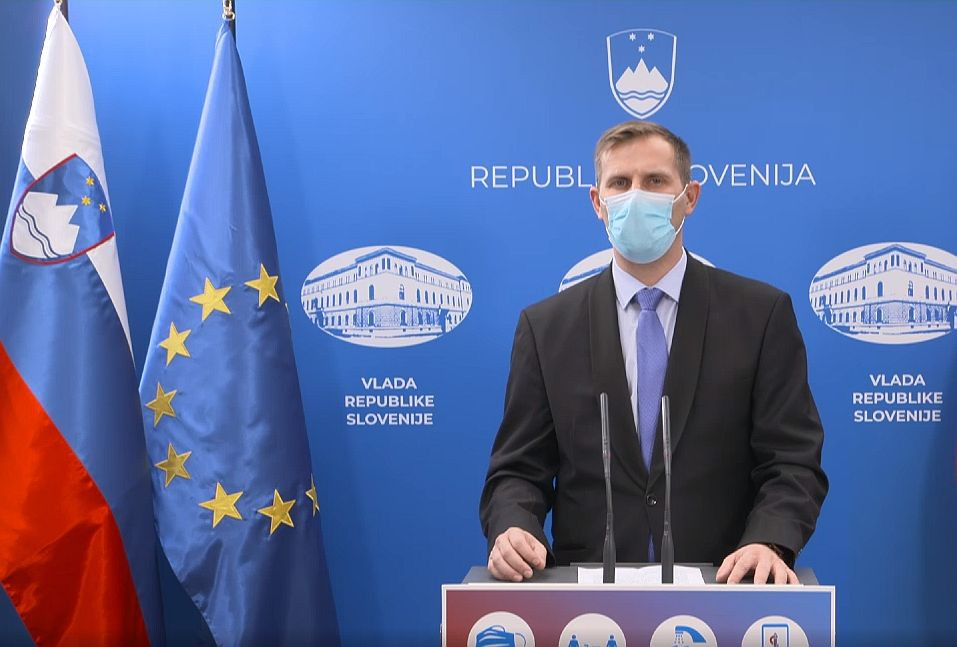Total number of positive rapid and PCR tests falls below 1,000 on a workday after extended period above threshold

Chief inspector at the Slovenian Education and Sport Inspectorate Simon Slokan | Author Urad vlade za komuniciranje
5,247 PCR tests were conducted yesterday, with 779 (14.8%) new positive cases confirmed.
Of the 7,657 rapid tests performed, 180 (2.4%) were positive. A total of 959 positive cases were confirmed. 988 patients are hospitalised, with 161 in intensive care, which is four fewer than the previous day. There were fourteen deaths, eleven in hospitals.
According to the Easing of Restrictions Roadmap, we are currently in the red phase. According to the data released by the NIJZ yesterday, the seven-day average number of infections was 1,076, while the number of persons requiring hospitalisation due to COVID-19 was 988 yesterday. Both of these criteria have to fall below 1,000 in order to transition into the next, orange phase.
As of today, galleries, libraries and museums are open throughout Slovenia, ski areas throughout Slovenia will be opening on Saturday, and schools and kindergartens on Tuesday. Changes are in effect from today onward with regard to exceptions for crossing the border, relating to (i) fewer exceptions for entry without quarantine and a negative test and (ii) exceptions introduced for entry without quarantine on the condition of a negative PCR or rapid test not older than seven days.
Schools and kindergartens adhering to NIJZ recommendations
According to Slokan, the role of the Education and Sports Inspectorate is to use control mechanisms, and also quality assurance mechanisms in education, to detect failures to comply with the ordinances to prevent the spread of the virus. From mid-October to the present, the inspectorate has conducted 1,435 inspections at educational and training institutions, during which the inspectors did not identify any major discrepancies, as the schools and kindergartens are well prepared and adhere to both all of the recommendations of the National Institute of Public Health and the provisions of the ordinances which impose the individual measures.
Article 2 of the Ordinance on temporary measures to reduce the risk of infection with the SARS-CoV-2 virus and contain the spread of infection stipulates that masks are required in all indoor spaces, while Article 3 sets out the exceptions, including exceptions relating to schools: (i) protective masks are not required for children up to 6 years of age, (ii) they are not required for schoolchildren in their classrooms, and (iii) they are not required for kindergarten teachers, teaching assistants and teachers up to the 5th year when working directly with children.
In other words, this means that masks are required in common areas (hallways, staff rooms, cafeterias, bathrooms). They are also required at kindergartens for activities not involving working directly with children.
Bearing in mind the social responsibility of every individual, everyone who enters the education and training system process has their own responsibility. The principal is responsible for organising work and activities systematically and enforcing the measures introduced to reduce the risk of transmitting the disease. If the individuals who enter these spaces (e.g. teaching staff, other employees, students, parents, other parties) fail to follow, ignore or intentionally flout the aforementioned recommendations, the principal cannot assume responsibility for all of the issues in question. It is the personal responsibility of each individual to adhere to the measures introduced at individual institutions in order to reduce the risk or spread of infection.
Experiences with opening and closing schools in Italy
After the Mardi Gras holiday last year, Italian primary and secondary school students were expecting to return to school on 27 February 2020. However, due to the epidemic, all schools remained closed until the end of the school year, i.e. 12 June 2020, said Terpin. Graduates took an abbreviated version of their school leaving exams at the end of June. They studied for the exams remotely, and sat them in person, but were limited to at most a one-hour oral exam. The exam committees were composed of school staff; only the committee chairs came from outside the institutions.
The schools were reopened at the beginning of the new school year, on 14 September 2020, without suitable attention being paid to the adaptation of the provision of public transport, which is one of the most dangerous environments for the spread of infections. Eight million primary and secondary school students and two million teachers, professors and non-teaching staff began to move and gather, which in the opinion of epidemiologist and virologist Dr Massimo Galli, primary infectious diseases specialist at the Luigi Sacco hospital in Milan, caused an explosion of positive cases and the return of exponential growth.
All secondary schools, or upper secondary schools as they are called in Italy, were re-closed at the end of October 2020, while classes were continued to be held only in kindergartens and primary schools, in Italy called primary or lower secondary schools. Certain regions had already closed their schools due to the worsening epidemiological situation. The schools remained closed until 1 February 2021, when secondary school students once again returned to their classrooms, but only up to 50 percent capacity, meaning only Monday, Wednesday and Friday, with distance learning being held on Tuesday, Thursday and Saturday.

